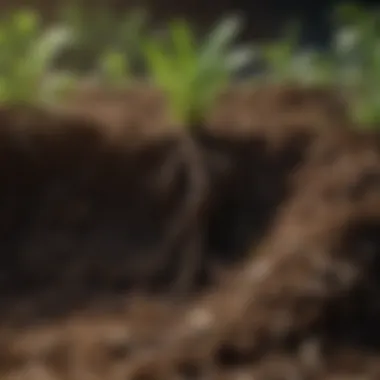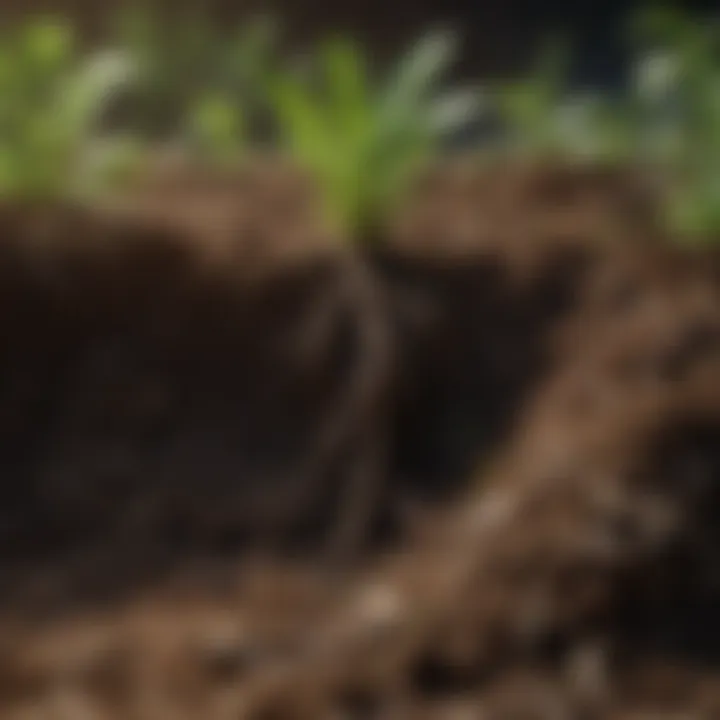Starting Your Planting Journey: A Comprehensive Guide


Intro
Starting a planting journey involves multiple layers of knowledge and practical application. This guide aims to detail the essentials you need for successful gardening. The process is not merely about placing seeds in the ground. It encompasses understanding your environment, choosing the right plants, ensuring soil health, and applying sustainable practices.
By systematically navigating through these components, you can transform your space into a thriving garden.
Key Insights and Trends
Gardening today is characterized by several emerging insights. Homeowners increasingly seek to create personal oases that reflect their tastes and aspirations. Here are some trends regarded in the gardening community:
- Diversity in Plant Choice: Homeowners are exploring various plants that suit specific microclimates in their yards. Native plants are particularly favored as they require less maintenance and support local ecosystems.
- Edible Landscaping: There has been a noticeable shift toward incorporating edible plants into traditional gardens. This trend encourages both aesthetics and practicality.
- Vertical Gardening: With urban spaces often lacking in ground area, vertical gardening has surged in popularity. Using walls and trellises to grow plants not only saves space but can also be visually appealing.
Current trends in interior design
While gardening primarily focuses on the outdoor environment, there is a crossover into interior design. Incorporating plants inside the home is gaining traction. Interior gardening offers both aesthetic appeal and health benefits. Houseplants can improve air quality and boost mood.
Practical Tips and How-To Guides
Starting your planting journey does not have to be overwhelming. Here are structured steps to get you going:
- Research Your Environment: Assess the layout of your garden. Knowing your hardiness zone, sunlight exposure, and soil type is crucial.
- Select Suitable Plants: Choose plants that thrive in your specific conditions. Consider the required sunlight, watering needs, and growth habits.
- Health of Soil: Test your soil to determine its pH and nutrient content. Amend it accordingly with compost or fertilizers to promote plant growth.
- Watering Techniques: Establish a consistent watering schedule. It is important to prevent both overwatering and drought stress.
- Sustainable Practices: Emphasize practices such as crop rotation and organic pest control. Sustainability should be a foundational aspect of your gardening choices.
"Effective gardening encompasses understanding one’s environment and choosing the right plants, ensuring a sustainable approach to care."
These insights and tips offer essential knowledge applicable to both beginner and seasoned gardeners. With each step, you gain more understanding, leading to a flourishing gardening experience.
Preamble to Planting
Starting your planting journey holds significant value, not only for personal satisfaction but also for enhancing your living environment. Gardening promotes well-being and encourages an appreciation for nature. Additionally, it serves as a practical way to ensure access to fresh produce, reduce stress, and enhance aesthetic appeal. Understanding the fundamentals of planting enables one to make informed choices about the types of plants that will thrive in specific conditions.
Understanding the Importance of Gardening
Gardening is a multifaceted activity with numerous benefits. For homeowners, it provides a connection to nature often lost in urban settings. Moreover, engaging in gardening contributes positively to mental health, offering a productive outlet for creativity and nurturing tendencies. Each plant nurtured symbolizes growth, offering a profound satisfaction that comes from caring for living things.
In environmental terms, gardening plays a critical role as well. It enhances biodiversity by attracting various pollinators like bees, butterflies, and birds. Dedicating space for plants can aid in improving air quality and combat climate change. Understanding this importance lays the groundwork for effective practices in gardening.
Reasons to Start Planting
There are many reasons to begin your planting journey. Here are some compelling motivators:
- Health Benefits: Growing your own food encourages healthier eating habits. Fresh vegetables and fruits contain essential nutrients and fewer chemicals compared to store-bought options.
- Cost Efficiency: Establishing a garden can significantly lower grocery expenses over time. Once established, many perennials can produce for years with minimal investment.
- Environmental Contribution: Personal gardening efforts reduce carbon footprints. Using sustainable practices can diminish the impact on the environment, fostering a culture of care for nature.
- Skill Development: Gardening fosters numerous skills, including patience, attention to detail, and problem-solving. It can also serve as a lifelong learning experience.
- Social Connections: Joining gardening communities—whether online at platforms like Reddit or real-world gatherings—expands social networks and creates shared experiences.
Identifying Your Space for Planting
Choosing where to plant is a foundational step in the gardening process. This stage strongly influences the overall success of your garden. It encompasses various factors, such as light availability, soil type, and accessibility. Understanding your gardening space assists in making informed decisions about which plants to cultivate. Additionally, the right location optimizes growth, enhancing both yield and beauty.
Assessing Sunlight and Microclimates
Sunlight is a critical element affecting plant growth. Different plants require varying amounts of sunlight. Therefore, assessing your garden’s sunlight exposure is essential. Observe your space throughout the day. Note areas receiving full sun, partial shade, or full shade. Full sun areas typically receive at least six hours of direct sunlight daily. This is ideal for many flowering plants and vegetables, which thrive in bright conditions.
Partial shade provides a balance, making it suitable for plants that thrive in a mix of sun and shade. In contrast, full shade may limit plant choices, as many plants struggle without ample light.
In addition to sunlight, be aware of microclimates. These are small areas that have slightly different climates due to topographical elements or structures like buildings and trees. For instance, a south-facing wall may retain heat better than a north-facing area. Identify these pockets within your space; they may allow for more diverse planting options than initially thought.
Choosing the Right Location
After assessing sunlight and microclimates, it is time for the next step: choosing the right location. This includes evaluating soil conditions and drainage options. Good drainage is vital to prevent waterlogging, which can damage roots.
Examine the soil type in your chosen area. If the soil is compacted, it may need amendments to improve aeration and nutrient availability. Soil with high clay content may require organic matter, such as compost, to enhance its texture. Additionally, a location near a water source simplifies irrigation.
Consider accessibility as well. Ensure that your garden is easy to reach for regular maintenance and harvesting. The experience can quickly become frustrating if bending over or walking through thorny shrubs is required.
Selecting Plants for Your Garden
Choosing the right plants for your garden is crucial. This decision fundamentally shapes the success of your gardening efforts. Different plants thrive in different environments, and understanding their needs can make a significant difference. Factors such as climate, soil type, and sunlight exposure influence the plants' growth and health. By carefully selecting plants that match your specific conditions, you create a more robust garden scenario. This approach minimizes the risk of plant failure and optimizes the aesthetics and functionality of your space.
Seasonal Planting Considerations


When planning your garden, seasonal timing is essential. Different plants have specific growing seasons. For example, cool-season vegetables like lettuce and spinach do well in spring, while warm-season crops such as tomatoes and peppers thrive in summer.
To ensure success, consider the following:
- Frost Dates: Know your local frost-free dates to prevent damage.
- Planting Zones: Understand your USDA hardiness zone. This knowledge helps in selecting plants suited to your climate.
- Crop Rotation: Plan for a rotating schedule to improve soil health and reduce pests.
Using these factors helps create a well-timed planting schedule.
Native vs. Exotic Plants
Deciding between native and exotic plants is another critical element. Native plants are species that naturally grow in your area. They typically require less maintenance, as they are adapted to your local climate and soil conditions. Additionally, they support local ecosystems, providing habitats for wildlife.
On the other hand, exotic plants can add diversity and unique aesthetics to your garden. However, they may require more care and can sometimes disrupt local ecosystems.
Here are some considerations:
- Adaptation: Native plants are often more resilient.
- Maintenance Needs: Exotic plants may need specific nutrients or care.
- Biodiversity: Native species enhance local ecology, while exotics can attract pests.
Perennials, Annuals, and Biennials
Understanding whether to plant perennials, annuals, or biennials is essential. Each type plays a different role in your garden.
- Perennials: These plants return year after year, making them a long-term investment. They provide stability and usually require less maintenance once established.
- Annuals: These plants complete their life cycle in one growing season. They offer vibrant colors but need replanting each year. They are great for seasonal displays.
- Biennials: These plants require two years to complete their life cycle. They can provide unique blooms in their second year, offering diversity in garden design.
Choosing the right mix of these plants creates a balanced garden that offers beauty and sustainability.
Understanding Soil Health
Soil health is a fundamental aspect of successful gardening. It acts as a foundation that supports plant growth. Poor soil can result in weak plants and limited growth potential. Hence, understanding soil health enables gardeners to create a thriving ecosystem for their plants. Healthy soil promotes better nutrient availability, enhances water retention, and fosters beneficial microorganisms. These factors are key to sustaining plant life and contribute to the overall effectiveness of one's gardening efforts.
The Importance of Soil Quality
Soil quality directly affects how well plants can grow. High-quality soil contains a balance of nutrients such as nitrogen, phosphorus, and potassium. Moreover, good soil has a structure that allows for air and water movement. This balance is essential. When soil lacks quality, it can lead to issues such as poor drainage, which can suffocate roots and hinder growth. Therefore, investing in soil quality can lead to a richer and more fruitful gardening experience.
Testing Soil Composition
Testing soil composition is a crucial step in understanding its health. Homeowners and gardening enthusiasts can easily collect soil samples from their garden. Using a simple soil test kit, one can determine pH levels as well as nutrient concentrations. Most plants thrive in slightly acidic to neutral soil, with a pH of around 6 to 7. If the soil is too acidic, amendments can be made to correct the pH. Testing provides insights into soil fertility and helps in making informed decisions regarding plant varieties that would be suitable for specific conditions.
Amending Soil for Optimal Growth
Amending soil is necessary to achieve optimal growth conditions. Various substances can be added, such as compost, peat moss, or perlite, to enhance soil structure and fertility. Compost enriches the soil with organic matter and nutrients. Furthermore, adding amendments helps in improving drainage and moisture retention. It is essential to know the specific needs of the plants you wish to grow in order to tailor your amendments. This tailored approach leads to healthier plants with more robust growth. Regular soil amendment not only supports current plants but can also prepare the soil for future planting seasons.
"Healthy soil is a living ecosystem, and understanding its complexity is vital for every gardener."
In summary, understanding soil health is paramount to a successful gardening journey. Focus on soil quality, test its composition, and amend it as needed. This ensures that your plants have the best possible foundation to thrive.
Planting Techniques
Planting techniques serve as the foundation for a successful garden. Without proper techniques, the plants may struggle to grow and thrive. This section will cover important planting methods, ensuring that readers grasp their significance in nurturing a healthy garden. By understanding the essential steps involved in planting, homeowners can significantly improve the productivity and aesthetics of their gardening efforts. Careful consideration of initial steps, transplanting practices, and spatial arrangements leads to optimal plant growth.
Initial Planting Steps
Before placing seeds or seedlings in the soil, some steps should be taken to prepare. First, gather all necessary tools and materials. This typically includes trowels, watering cans, and gloves. It is vital to have healthy seedlings or seeds, as quality directly affects growth potential.
Soil Preparation: Creating a suitable environment for plants starts with soil. Testing for pH and nutrient levels can offer insight into what amendments are necessary. Usually, people incorporate organic matter like compost to improve soil structure and fertility.
Sowing Seeds or Setting Seedlings: For seeds, follow the packet instructions regarding depth and spacing. Generally, a rule of thumb is to plant seeds two to three times their diameter deep. When transplanting seedlings, ensure their root systems are not disturbed excessively. Making a hole in the soil to the adequate depth encourages healthy growth.
Transplanting Seedlings
Transplanting is a critical phase in the planting process. Seedlings can become root-bound if left in small containers too long. Therefore, it is important to monitor their growth. When transferring seedlings, timing is essential. Ideally, wait until they have a few sets of true leaves.
Before transplanting, water the seedlings gently to reduce root shock. Select a day that is cooler to minimize stress on the plants. When removing the seedlings from their containers, grasp them gently by the leaves, not the stems. This careful handling ensures minimal damage.
Once seedlings are placed in their new location, water again. This promotes settling and creates good soil contact, essential for nutrient uptake.
Spacing and Layout Considerations
Proper spacing between plants is crucial for air circulation, sunlight exposure, and resource allocation. Crowded plants tend to compete for nutrients and may lead to disease issues. Planning layout will enhance both aesthetic appeal and plant health.


Determining Spacing Needs: Each type of plant has unique spacing requirements. For instance, larger plants like tomatoes need more space compared to herbs. Always check specific plant guidelines for recommended distances.
Vertical Gardening Benefits: Utilizing vertical space, such as trellises for climbing plants, can maximize garden area. This practice aids in airflow while allowing more variety in a limited space.
Garden Design Principles: Think about aesthetics when laying out the garden, such as color schemes and heights. Layering taller plants behind smaller ones creates a visually appealing design. Opting for companion planting can also benefit plants, as some varieties help deter pests while enhancing growth for neighboring species.
"Effective planting techniques empower gardeners to optimize growth potential and cultivate flourishing gardens."
By mastering these planting techniques, gardeners can ensure the foundation of their garden is strong. Solid planting practices lead to a greater likelihood of success as the garden matures. Ultimately, these basic yet effective skills are essential for anyone embarking on their planting journey.
Watering and Maintenance
Watering and maintenance are crucial components of successful gardening. These practices can determine the overall health and productivity of your plants. Understanding how to establish a consistent watering routine and the role of mulching can greatly enhance the sustainability and efficiency of your garden.
Effective watering keeps plants hydrated, encourages growth, and helps in nutrient absorption. Additionally, proper maintenance ensures that the garden remains free of pests and diseases, allowing your plants to thrive. Skipping these essential practices can lead to wilting, stunted growth, or plant death.
Establishing a Watering Routine
Creating a watering routine is essential to ensure that your plants receive the right amount of moisture. Plants have varying water requirements based on their type, size, and surrounding environment. A well-planned routine helps avoid overwatering or underwatering.
- Check Soil Moisture: Before watering, it is vital to check the soil moisture. Stick your finger into the soil about one inch deep; if it feels dry, it is time to water.
- Time of Day: Watering early in the morning is often recommended. This allows plants to absorb moisture before the heat of the day, reducing evaporation.
- Amount of Water: When watering, aim to provide enough so that water seeps down to the root zone. Deep watering encourages roots to grow further into the soil for better access to nutrients.
- Frequency: This varies based on the season and weather conditions. Generally, once a week may be sufficient, but more frequent watering may be required during hot, dry periods.
Mulching for Moisture Retention
Mulching is an effective strategy for maintaining soil moisture and regulating temperature. It involves covering the soil surface around plants with organic or inorganic materials. This practice provides multiple benefits:
- Moisture Retention: A layer of mulch acts as a barrier, reducing evaporation and keeping moisture in the soil.
- Temperature Control: Mulch helps insulate the soil, keeping it cooler in the summer and warmer in the winter.
- Weed Suppression: A thick layer of mulch can prevent weeds from competing with your plants for water and nutrients.
When selecting mulch, consider organic options like wood chips, straw, or grass clippings. These not only provide a moisture-retaining cover but also decompose over time, adding nutrients back into the soil.
Proper mulching is essential for a healthy garden. It enhances moisture retention and reduces the need for constant watering, saving time and effort.
Plant Care Practices
Plant care practices are fundamental to the success of any gardening endeavor. They encompass various strategies that ensure the health, growth, and productivity of your plants. Proper care helps plants thrive and contributes to the overall aesthetic and ecological benefits of a garden. Understanding these practices is vital for both novice and experienced gardeners. Through effective plant care, you can minimize issues that might arise during the growing season and enhance your gardening experience.
Fertilization Techniques
Fertilization is a critical aspect of plant care, providing essential nutrients that act as the building blocks for plant health. Without proper fertilization, plants can struggle, becoming weak and vulnerable.
When choosing a fertilizer, it is important to consider the specific needs of your plants. Here are a few techniques to keep in mind:
- Organic vs. Synthetic Fertilizers: Organic fertilizers are derived from natural sources like compost or manure, while synthetic fertilizers are chemically manufactured. Each has its own advantages. Organic options enhance soil structure and encourage microbial activity. Synthetic fertilizers deliver nutrients quickly but may not support long-term soil health.
- Slow-release vs. Quick-release: Slow-release fertilizers provide nutrients over an extended period, minimizing the risk of over-fertilization. Quick-release fertilizers act rapidly, making them suitable for specific growth phases, such as when plants are seedlings.
- Application Timing: Knowledge of when to fertilize is critical. Generally, it's best to fertilize during active growth periods in spring and early summer. However, monitor your plants; if you see signs of nutrient deficiency, a top dressing might be necessary.
- Testing Soil: Conducting a soil test can provide insights into nutrient levels already present in the soil. This allows for more tailored fertilization, preventing problems associated with excess nutrients.
Pest and Disease Management
Effective pest and disease management is essential to maintain a healthy garden. Unchecked pests can destroy plants, and diseases can spread rapidly, compromising entire crops. Understanding integrated pest management (IPM) practices is crucial for sustainable gardening.
- Regular Monitoring: Regularly checking plants for signs of pests or diseases is one of the best preventive measures. Early detection can make a significant difference in the outcome. Look for discoloration, wilting, or unusual growth patterns.
- Natural Predators: Encouraging natural predators, such as ladybugs and lacewings, can help control pest populations. Introducing plants that attract these beneficial insects can create a balanced ecosystem.
- Cultural Practices: Implementing good cultural practices like crop rotation, proper spacing, and watering techniques can help reduce disease incidence. Crop rotation prevents the buildup of pests and diseases specific to certain plants.
- Organic Treatments: When pests or diseases are identified, treatments range from neem oil to diatomaceous earth. These organic options tend to be less harmful to beneficial insects and the environment.
By embracing these plant care practices, gardeners increase their chances for a flourishing and productive garden. Attention to fertilization and pest management not only enhances plant health but also cultivates a sustainable approach to gardening.
Sustainable Gardening Practices
Sustainable gardening practices are essential for maintaining ecological balance, conserving resources, and ensuring the longevity of gardening endeavors. These methods focus on utilizing techniques that are environmentally-friendly, reducing waste, and promoting biodiversity. With increased awareness about climate change and environmental degradation, sustainable gardening has gained importance. Implementing such practices in your gardening journey not only benefits your local ecosystem, but also contributes to a healthier planet. By adopting sustainable methods, gardeners can create a space that thrives both individually and as part of a larger environmental system.
Composting Basics
Composting is a vital component of sustainable gardening. It involves recycling organic waste, such as kitchen scraps and garden debris, into nutrient-rich soil. This process not only reduces landfill waste but also enriches the soil without the need for chemical fertilizers. The composting process typically includes several steps:
- Selecting a Compost Bin: Choose a bin that fits your space and needs. It can be a simple pile, a manufactured bin, or even a worm composting setup.
- Layering Materials: Start with a mix of green materials (nitrogen-rich) such as vegetable scraps, grass clippings, and brown materials (carbon-rich) like dried leaves and straw. A balanced mix is essential for effective decomposition.
- Maintaining the Pile: Turn the compost pile regularly to aerate it and promote even decomposition. Monitor moisture; it should be damp but not soaked.
- Using Finished Compost: In a few months, the compost will break down into a dark, crumbly substance. This can be incorporated into the soil to improve its structure, water retention, and nutrient content.
Composting, hence, is important for sustaining soil health and minimizing waste in a gardening practice.
Water Conservation Techniques
Water conservation is another key aspect of sustainable gardening. With growing concerns over water scarcity, implementing efficient watering techniques can significantly reduce water usage while maintaining healthy plants. Some effective water conservation methods include:


- Mulching: Apply organic materials around plants to prevent moisture loss through evaporation. Mulch also helps suppress weeds and regulate soil temperature.
- Drip Irrigation: This efficient method delivers water directly to the roots of plants, minimizing evaporation and runoff. It is ideal for vegetable gardens and flower beds.
- Rainwater Harvesting: Collecting rainwater from rooftops can provide an additional source of irrigation. This can be stored in barrels and used during drier periods.
- Drought-Resistant Plants: Incorporate native and drought-resistant species into your garden. These plants require less water and are often more adaptable to local conditions.
By being mindful of water usage in your gardening efforts, you conserve this valuable resource and protect the environment.
Troubleshooting Common Issues
Gardening is often celebrated for its rewards, but it can also present various challenges. Recognizing and addressing these common issues is vital for the long-term health of your plants. This section aims to equip you with the knowledge needed to troubleshoot efficiently. Understanding the common problems allows you to take proactive measures, preventing minor issues from escalating into crises.
Identifying Nutrient Deficiencies
Nutrient deficiencies are a common issue gardeners face. Plants require a balanced supply of nutrients to thrive. When these are lacking, you may see visible signs that can indicate what nutrients are missing. Common deficiencies include:
- Nitrogen Deficiency: Leaves turn yellow, particularly older leaves. Growth slows down.
- Phosphorus Deficiency: Older leaves may become dark green. Growth is often stunted.
- Potassium Deficiency: Yellowing of leaf edges, poor fruit development.
To identify these deficiencies, observe your plants regularly. Early intervention is crucial. You can also conduct soil tests to clarify nutrient content. Soil testing kits are relatively inexpensive and provide a detailed analysis of nutrient levels in your soil. Adjusting your fertilization methods based on this information can lead to healthier plants.
Dealing with Weather Challenges
Weather plays a significant role in gardening success. Excessive rain, drought, temperature fluctuations, and other weather-related factors can adversely affect your plants. Here are some strategies to mitigate these challenges:
- Invest in Good Drainage: If you reside in an area susceptible to heavy rainfall, ensure your garden has good drainage systems. Raised beds can help prevent root rot and other water-related issues.
- Mulch for Temperature Regulation: Applying mulch can protect plant roots from extreme temperatures. It keeps the soil cooler during dry spells and warmer during cold snaps.
- Use Row Covers: For unexpected frosts, lightweight row covers can protect tender plants, providing a barrier against cold while allowing light in.
Observing weather patterns can also assist in making informed gardening decisions. Pay attention to seasonal changes and historical weather data for your area. Adjust your planting schedule or select more resilient plant varieties that match your local conditions, enhancing your gardening resilience.
"Gardening requires the ability to take the long view, a patient perspective that sees challenges as opportunities for learning."
Through careful monitoring and adaptive strategies, you can significantly reduce the impact of common gardening issues, allowing your garden to flourish. A proactive approach not only saves time and effort but also brings satisfaction as you witness healthy plant growth.
Harvesting and Enjoying Your Plants
Harvesting plants is a crucial phase in the gardening journey. It represents the culmination of all the efforts put into initial planting, nurturing, and maintaining the garden. Understanding how and when to harvest is not only rewarding, but it also ensures that the produce is at its peak flavor and nutrition.
Recognizing Harvest Times
Timing is everything when it comes to harvesting. Each type of plant has specific indicators that signal when it is ripe for picking. For instance, tomatoes should be harvested when they are fully colored and slightly firm to the touch. On the other hand, leafy greens like spinach are best enjoyed when they have reached a certain size but before they bolt, which means they begin to flower and go to seed.
To determine the optimal harvest time, consider the following:
- Consult Plant Guides: Many seed packets or gardening books provide guidance on when to harvest specific plants.
- Observe Changes: Monitor color, size, and firmness. A ripe bell pepper will change from green to its mature color, red or yellow.
- Taste Test: Sampling a small piece can often provide the best insight into whether a fruit or vegetable is ready.
By being attentive to these indicators, gardeners can maximize the quality of their harvests.
Utilizing Fresh Produce
Once harvest is complete, the next step is making the most of what has been gathered. Fresh produce can be used in numerous ways, elevating meals and offering health benefits. Here are some ideas to consider:
- Culinary Use: Incorporate freshly harvested vegetables into salads, stir-fries, or soups. Use herbs to enhance flavors in various dishes.
- Preservation: If there is an excess, consider freezing, drying, or canning them for future enjoyment. This allows for the retention of flavor and nutritional value long after harvesting season ends.
- Sharing: Gift fresh produce to friends and family. Sharing your bounty can foster connections and spread joy.
"The joy of gardening is not just in the growing but in the sharing and enjoying of the fruits of one's labor."
By utilizing fresh produce, individuals not only complement their diet but also appreciate the hard work involved in gardening.
Continuing Your Gardening Journey
Continuing your gardening journey is an essential theme to explore, especially after the initial excitement of planting. Gardening is not a one-time activity; it evolves over time. This section aims to delve into planning for future seasons and expanding your gardening skills. These two elements are crucial for any gardener who desires to enhance their gardening experience and achieve greater success in their endeavors.
Planning for Future Seasons
Planning for future seasons involves a strategic approach to gardening. It's not just about what you grow this year but also about how you can improve and adapt with each passing season. Knowing the cycles of different plants helps you optimize your garden's yield. Start by assessing what worked well in the previous seasons and what did not.
Here are a few tips to consider:
- Create a Schedule: Develop a seasonal planting schedule. This will help you remember when to plant different varieties and ensure a continuous harvest.
- Rotate Crops: Practice crop rotation. It helps prevent soil depletion and reduces pest issues. Different plants have varying nutrient needs.
- Consider Climate Changes: Be mindful of climate changes. Adjust your plans based on seasonal weather patterns, which can have significant effects on plant growth.
Planning also includes experimenting. Different plants respond differently based on various factors. Looking into companion planting, for instance, can increase plant health and yield.
Expanding Your Gardening Skills
Expanding your gardening skills is another vital aspect. A gardener's knowledge base should not remain stagnant. Engaging in continuous learning allows you to encounter new techniques and ideas. Workshops, books, and even online resources can provide invaluable information.
Consider the following when expanding your skills:
- Join Community Groups: Participate in local gardening groups or online forums, like those on reddit.com. Engaging with other gardeners can provide insight and support.
- Experiment with New Techniques: There are many gardening methods, such as hydroponics or permaculture. Experiment to see what fits your gardening style and environment best.
- Stay Updated on Gardening Trends: Follow developments in sustainable gardening practices or new plant varieties. This helps you keep your garden relevant and productive.
In summary, continuing your gardening journey through thoughtful planning and skill expansion lays the groundwork for a thriving garden through each season. Embrace the opportunity to learn and grow, both in your garden and as a gardener.



